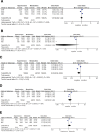Elevated isoleucine may be a protective factor for primary hypertension: A pooled causal effect study
- PMID: 40020104
- PMCID: PMC11875580
- DOI: 10.1097/MD.0000000000041651
Elevated isoleucine may be a protective factor for primary hypertension: A pooled causal effect study
Abstract
Hypertension continues to pose a huge burden to global public health. Abnormal metabolism not only serves as a risk factor for hypertension but also acts as a driving force in its aggravation. However, there remains a lack of large-scale causal demonstration based on extensive samples. Our study aims to investigate the causal relationship between metabolism and primary hypertension (PH) using Mendelian randomization analysis. We used genome-wide association studies instrumental variables for Mendelian randomization association analysis integrating the diagnosis results of PH in 3 populations from East Asia, the Middle East, and Africa with serum metabolites and metabolite ratios. This allowed us to identify predictive metabolites and metabolic pathways for diagnosing or treating PH. Inverse-variance weighting was the main model for establishing causal associations. In addition horizontal pleiotropy test, linkage disequilibrium test, and sensitivity analysis were employed to test the explanatory power of instrumental variables. A total of 10,922 cases of PH and 8299 cases of metabolomics detection cohorts were included in the study. In East Asian, Middle Eastern, and African populations, we found 36, 57, and 40 known metabolites respectively strongly associated with PH (P < .05). Cross-section and meta-analysis of these strongly correlated metabolites across the 3 ethnic groups revealed 7 common metabolites. Notably, elevated isoleucine (odds ratio = 0.74, 95% confidence interval: 0.56-0.96) was demonstrated as a potential protective factor against PH across 3 ethnic groups. The metabolites associated with PH have certain polymorphisms in different populations. Isoleucine may be a promising biomarker for PH diagnosis or treatment, but more clinical validation is needed.
Copyright © 2025 the Author(s). Published by Wolters Kluwer Health, Inc.
Conflict of interest statement
The authors have no conflicts of interest to disclose.
Figures





Similar articles
-
[Genetic Causation Analysis of Hyperandrogenemia Testing Indicators and Preeclampsia].Sichuan Da Xue Xue Bao Yi Xue Ban. 2024 May 20;55(3):566-573. doi: 10.12182/20240560106. Sichuan Da Xue Xue Bao Yi Xue Ban. 2024. PMID: 38948277 Free PMC article. Chinese.
-
Causal Relationship Between Branched-Chain Amino Acids and Hypertension: A Mendelian Randomization Study.J Am Heart Assoc. 2024 Mar 5;13(5):e032084. doi: 10.1161/JAHA.123.032084. Epub 2024 Feb 29. J Am Heart Assoc. 2024. PMID: 38420789 Free PMC article.
-
Assessing the causal relationship between metabolic biomarkers and coronary artery disease by Mendelian randomization studies.Sci Rep. 2024 Aug 16;14(1):19034. doi: 10.1038/s41598-024-69879-2. Sci Rep. 2024. PMID: 39152174 Free PMC article.
-
Causality of genetically determined metabolites on anxiety disorders: a two-sample Mendelian randomization study.J Transl Med. 2022 Oct 20;20(1):475. doi: 10.1186/s12967-022-03691-2. J Transl Med. 2022. PMID: 36266699 Free PMC article.
-
Serum uric acid levels as a causal factor in hypertension: Insights from Mendelian randomization analysis.Clin Exp Hypertens. 2025 Dec;47(1):2496514. doi: 10.1080/10641963.2025.2496514. Epub 2025 May 5. Clin Exp Hypertens. 2025. PMID: 40325623 Review.
References
-
- Cuspidi C, Sala C, Tadic M, et al. . Untreated masked hypertension and carotid atherosclerosis: a meta-analysis. Blood Press. 2015;24:65–71. - PubMed
-
- Omboni S, Aristizabal D, De la Sierra A, et al. ; ARTEMIS (International Ambulatory Blood Pressure Registry: TEleMonitoring of Hypertension and Cardiovascular rISk Project) Investigators. Hypertension types defined by clinic and ambulatory blood pressure in 14 143 patients referred to hypertension clinics worldwide. Data from the ARTEMIS study. J Hypertens. 2016;34:2187–98. - PubMed
-
- Parati G, Lackland DT, Campbell NRC, et al. ; World Hypertension League. How to improve awareness, treatment, and control of hypertension in Africa, and how to reduce its consequences: a call to action from the world hypertension league. Hypertension. 2022;79:1949–61. - PubMed
MeSH terms
Substances
Grants and funding
LinkOut - more resources
Full Text Sources
Medical

